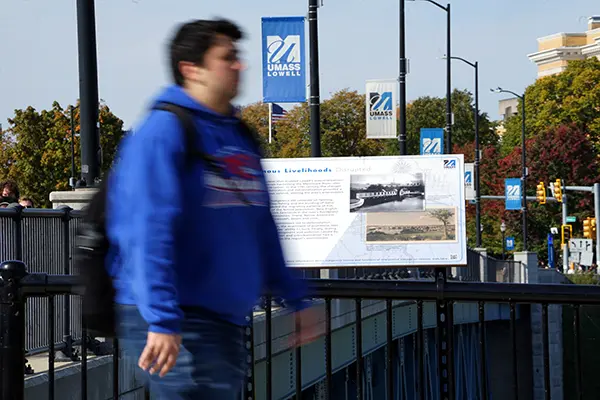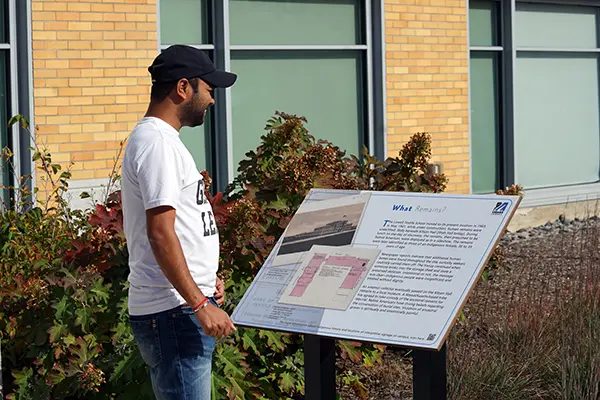Students, Faculty Collaborate to Remember the ‘History We Live With’
 Image by Ed Brennen
Image by Ed Brennen
10/13/2022
By Ed Brennen
Lowell’s backstory as the cradle of the Industrial Revolution is well-documented. Thanks to the work of several UMass Lowell students and faculty, the history of the Indigenous peoples who called this area home centuries before the textile mills came along is now being told — and in some unexpected places.
Led by History Professor Robert Forrant, the group created a half-dozen educational signs across campus to broaden community awareness and knowledge of the native Pawtucket and Wamesit people of the Pennacook tribe.
The “Indigenous Past and Presence” signage project will be the subject of a discussion on Nov. 7 (at a location still to be determined) as part of the university’s observance of Native American Heritage Month.
“Before this was an immigrant neighborhood, it was Indigenous,” says Forrant, who led a similar project about the city's French Canadian immigrants. “We’re now the next group of people physically inhabiting the space, so it’s good for people to understand that history.”
The Pawtucket were the earliest known inhabitants of the area, according to the university’s Land Acknowledgement. Residing on the north side of the Merrimack River, they fished for migrating salmon, alewives and shad in the spring and would hunt and grow corn the rest of the year. The Wamesit, meanwhile, were established as a “praying town,” a community for Native American Christian converts, by the Puritan missionary John Eliot in 1653. The village was located at the confluence of the Merrimack and Concord rivers, in present-day downtown Lowell.
“Research-wise, it was fantastic to unravel the story. But the subject matter wasn’t exciting in terms of looking at the racism and treatment of the Indigenous peoples.” -History major Deirdre HutchisonAfter serving on a committee last year that led the university to begin recognizing Indigenous People’s Day alongside the Columbus Day holiday, Forrant says he wanted to do something “more concrete.” So he began working on the signage project with History Professor Christoph Strobel, who has several publications about Native Americans in New England, and Art and Design Associate Professor Ingrid Hess. The group collaborated with Tom “Eagle Rising” Libby of the Greater Lowell Indian Cultural Association.
With funding from the Provost’s Office, they were able to offer paid internships to three students: history majors Deirdre Hutchison and Sarah McDermott ’22, who helped research and write the text, and graphic design major Taylor Szeto, who composed the signs.
“I’m proud that students are paid for projects like this at UMass Lowell,” Hess says. “The Provost’s Office was very generous in making this happen, and I’m grateful that we had support from the administration.”
Sparking Conversations
Hutchison took on research for “What Remains?” — a sign that details the grim discovery of Indigenous bones during the construction of Kitson Hall (now Shah Hall) on North Campus in 1901.
“It was a known burial ground, and as they were digging up the bones and skeletons, people were literally running up and taking them like they were getting prizes at a carnival,” says Hutchison, who learned about a skeleton that was put on display during the workers’ lunch hour. “You can imagine these construction workers munching their sandwiches and looking at a dead person — somebody’s mother, brother or sister … a human being.”
To respect the burial ground, Hutchison wanted to locate the sign as close as possible to the spot where the remains were discovered. Records at the Center for Lowell History referred to them being found at a “boiler house,” but Hutchison only knew of the power plant behind Falmouth Hall, which wasn’t constructed until 1913.
 Image by Ed Brennen
Image by Ed Brennen
“Research-wise, it was fantastic to unravel the story,” says Hutchison, now a senior. “But the subject matter wasn’t exciting in terms of looking at the racism and treatment of the Indigenous peoples.”
Fragmented remains from the site that had been passed on to the Peabody Institute of Archaeology, located at Phillips Academy in Andover, Massachusetts, are being repatriated to the Wampanoag tribe for reburial.
McDermott, meanwhile, researched the history of the university’s former “Charlie Chief” mascot, which was changed to Rowdy the River Hawk in 1994. The move proved ahead of its time; in 2005, the NCAA adopted a policy prohibiting schools from “displaying hostile and abusive racial/ethnic/national origin mascots, nicknames or imagery.”
“UMass Lowell was definitely on the earlier side of changing mascots and paved the way for a lot of colleges to switch,” says McDermott, who notes that her high school in Billerica, Massachusetts, still uses the Indians mascot.
She hopes the sign, located at the Tsongas Center, “sparks conversations about the importance of imagery and of inclusive representation.”
Szeto, now a senior, says it was “an honor” to work on a project that educates people about Lowell’s Native American history.
Besides choosing the right kind of eye-catching typography, which needed to follow the university’s brand guidelines, Szeto says the most challenging part of the work was selecting proper imagery. That meant avoiding the use of stereotypical items like teepees and spearheads that would be inappropriate for Indigenous peoples of this area.
“Simplifying the image-making was the best direction,” says the Brookline, Massachusetts, native, who received guidance on the project from designers in UML’s Office of University Relations. “It didn't take away the message, but honored the people and information instead.”
Meanwhile, Forrant and Strobel worked on the remaining signs, which are located at the Northern Canal Overlook and at Allen House. The signs include the history of the Wamesit praying town; the Indigenous livelihoods disrupted by industrialization; and Lowell native Charles Herbert Allen, the first appointed U.S. governor of Puerto Rico, who profited from the island’s sugarcane at the expense of its Native peoples.
Each sign includes a QR code that can be scanned to access a university Indigenous Peoples LibGuide with more information on Indigenous history.
Strobel, who grew up in Germany, says it’s important to acknowledge the “not always nicest moments of our past.”
“It’s the history that we live with,” says Strobel, who likened the signs to public markers in Germany called Stolpersteine, or “stumbling blocks,” that remember victims of the Holocaust.
“The signs aim to provide some critical content about the past,” he says. “They seek to remind people of the legacies of colonization and a continuous Indigenous presence.”
